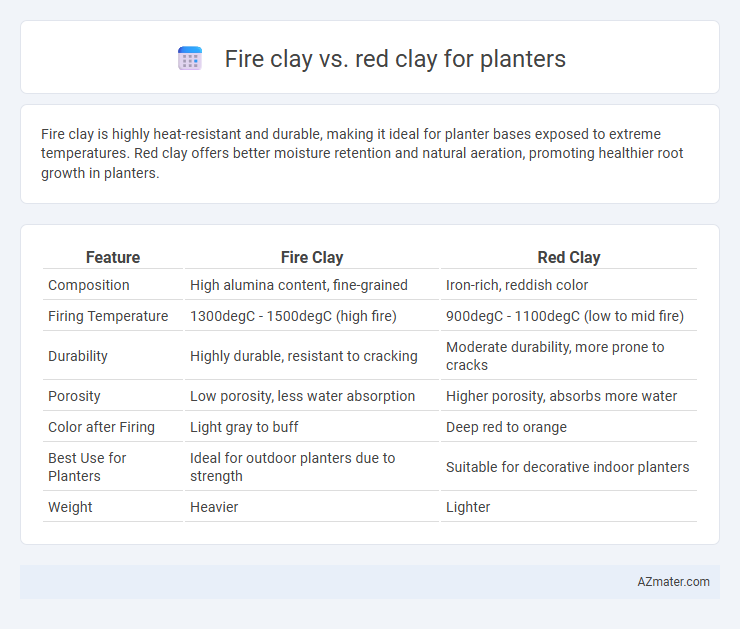Fire clay is highly heat-resistant and durable, making it ideal for planter bases exposed to extreme temperatures. Red clay offers better moisture retention and natural aeration, promoting healthier root growth in planters.
Table of Comparison
| Feature | Fire Clay | Red Clay |
|---|---|---|
| Composition | High alumina content, fine-grained | Iron-rich, reddish color |
| Firing Temperature | 1300degC - 1500degC (high fire) | 900degC - 1100degC (low to mid fire) |
| Durability | Highly durable, resistant to cracking | Moderate durability, more prone to cracks |
| Porosity | Low porosity, less water absorption | Higher porosity, absorbs more water |
| Color after Firing | Light gray to buff | Deep red to orange |
| Best Use for Planters | Ideal for outdoor planters due to strength | Suitable for decorative indoor planters |
| Weight | Heavier | Lighter |
Introduction to Fire Clay and Red Clay for Planters
Fire clay is a highly durable, heat-resistant material ideal for planters exposed to extreme temperatures, offering excellent structural integrity and low porosity that prevents water absorption. Red clay, known for its rich iron oxide content, provides natural breathability and moisture retention, promoting healthy root growth but tends to be less resistant to frost and cracking. Both clays are popular in planter manufacturing, with fire clay favored for its longevity and red clay chosen for its aesthetic appeal and natural drainage properties.
Key Differences Between Fire Clay and Red Clay
Fire clay is characterized by its high heat resistance and durability, making it ideal for planters exposed to extreme temperatures and weather conditions. Red clay, rich in iron oxide, offers excellent moisture retention and breathability, which benefits plant root health but may be less resistant to cracking in frost-prone areas. The key differences lie in fire clay's superior thermal stability and strength versus red clay's enhanced water absorption and natural coloration, influencing planter performance and aesthetics.
Physical Properties of Fire Clay vs Red Clay
Fire clay exhibits higher thermal resistance and durability compared to red clay, making it ideal for planters exposed to extreme temperature fluctuations. Its dense, fine-grained structure provides superior moisture retention and resistance to cracking under stress, whereas red clay tends to be more porous and brittle. The enhanced hardness and low permeability of fire clay contribute to longer-lasting planters with improved structural integrity over those made from red clay.
Durability and Longevity in Planters
Fire clay exhibits superior durability and longevity in planters due to its high resistance to heat, chemicals, and weathering, making it an ideal choice for outdoor use. Red clay planters, while aesthetically appealing with their warm, natural tones, are more porous and susceptible to cracking and erosion over time when exposed to moisture and temperature fluctuations. The dense composition of fire clay ensures enhanced structural integrity, resulting in planters that maintain their form and function significantly longer than those made from typical red clay.
Water Retention and Drainage Capabilities
Fire clay planters offer superior water retention due to their dense, vitrified structure, making them ideal for plants requiring consistent moisture. Red clay planters have more porous surfaces, enhancing drainage and preventing waterlogging but may require more frequent watering. Choosing between fire clay and red clay depends on the specific water retention and drainage needs of the plants being cultivated.
Suitability for Outdoor vs Indoor Planters
Fire clay offers superior durability and heat resistance, making it highly suitable for outdoor planters exposed to varying weather conditions and temperature fluctuations. Red clay, while aesthetically appealing and porous, is better suited for indoor planters where moisture and temperature are more controlled to prevent cracking and erosion. Choosing fire clay for outdoor use ensures long-lasting performance, whereas red clay best supports the humidity and temperature stability of indoor environments.
Aesthetic Qualities and Color Comparison
Fire clay planters showcase a rich, warm reddish-brown hue with subtle speckled textures that create a rustic yet refined aesthetic, enhancing garden spaces with natural earth tones. Red clay planters offer a more uniform, vibrant terracotta color that brightens outdoor areas and complements a variety of plant types with its classic Mediterranean appeal. The distinct color depth and surface finish of fire clay provide a visually textured, artisanal look, while red clay maintains a consistent, smooth appearance ideal for traditional or contemporary garden designs.
Plant Health: Impact on Root Development
Fire clay offers excellent drainage and aeration properties, promoting healthy root development by preventing waterlogging and root rot in planters. Red clay tends to retain more moisture, which can lead to poor oxygen availability and hinder root growth, especially for plants requiring well-drained soil. Choosing fire clay for planter composition enhances root health and supports robust plant growth.
Cost and Availability in the Market
Fire clay planters typically cost more than red clay due to their heat-resistant properties and higher durability, making them a premium choice in the market. Red clay planters are widely available and more affordable, appealing to budget-conscious buyers seeking natural aesthetics. Market availability of fire clay is relatively limited compared to the abundant supply of red clay, affecting pricing dynamics and accessibility.
Choosing the Best Clay for Your Planter Needs
Fire clay offers superior heat resistance and durability, making it ideal for outdoor planters exposed to varying weather conditions, while red clay is more porous and better suited for indoor or sheltered environments due to its excellent moisture retention. When choosing the best clay for your planter, consider fire clay for longevity and structural strength, especially in freezing climates, whereas red clay supports plant health by allowing better air and water permeability. Evaluate your local climate and plant type to select a clay that balances durability and optimal growing conditions.

Infographic: Fire clay vs Red clay for Planter
 azmater.com
azmater.com